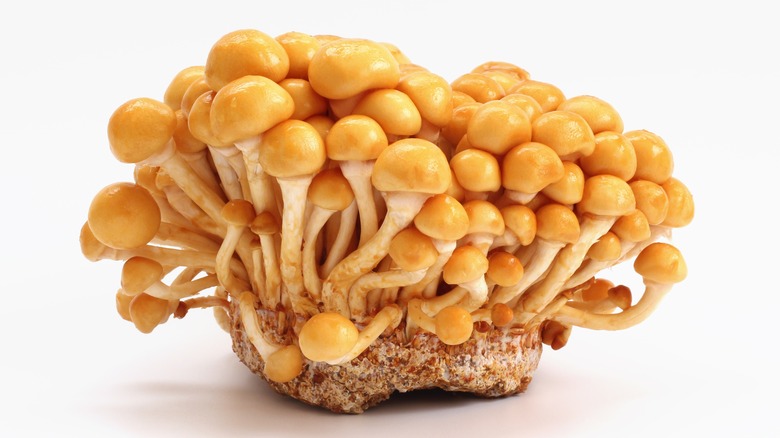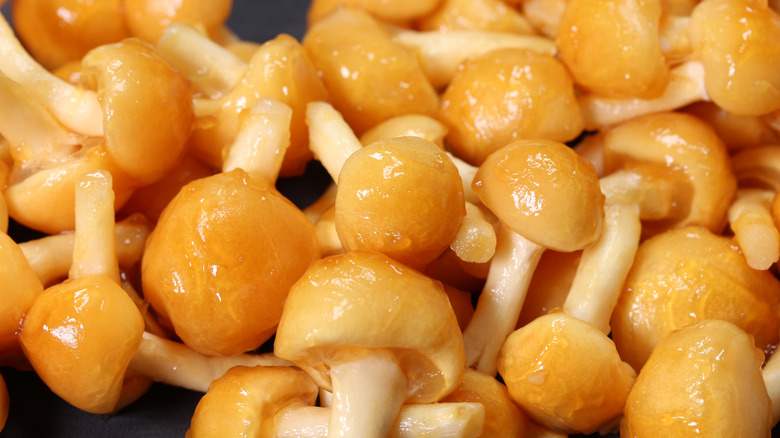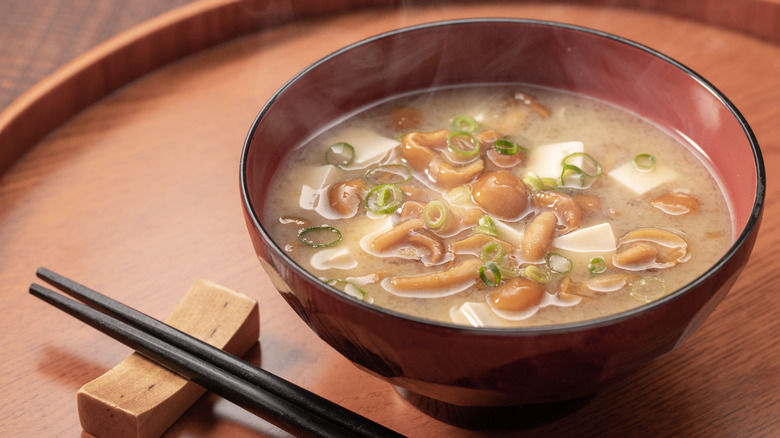Nameko: The Slimy Mushroom That Rules Japanese Cuisine
There are many types of mushrooms that factor into the American diet, but one you may not have heard of before is the nameko mushroom. That's because it grows in very few locations around the United States, or anywhere within the Western Hemisphere for that matter. This particular species is native to Asia, and while it can be found in many parts of the continent, it is most beloved in Japan, where its popularity is second only to that of the shiitake mushroom. Japan is also responsible for the mushroom's name, and what a telling name it is. "Nameko" is derived from the Japanese word "Numerikko," which translates to English as "slimy mushroom." Now, slimy can be a controversial texture (where are the okra lovers at?), but when it comes to nameko mushrooms, it's an essential part of their culinary appeal.
Although "nameko" isn't a familiar name to most Americans, there's a very good chance you've experienced them without even knowing it. Their unique texture makes them a critical part of traditional Japanese miso soup, as well as other soups, stews, and hot pots. The unique combination of flavor and consistency gives the nameko mushroom a wide range of uses that few other mushrooms can claim. Fortunately, nameko mushrooms are becoming easier to find outside of Asia, so there's never been a better time to add them to your culinary repertoire. But first we need to ask, what exactly are they?
What are nameko mushrooms?
"Nameko" is the most common colloquial name for Pholiota microspora, a member of the Strophariaceae family of mushrooms, which includes very few edible varieties, the most notable being the psychotropic mushrooms of the genus Psilocybe. Namekos have a very distinct appearance that makes them easy to identify. Each mushroom is only a few centimeters tall and wide, and they grow together in tight clusters. They grow in the wild between the months of October and February, popping up around the remnants of dead trees. Nameko mushrooms were once quite rare, regarded as a special delicacy, but the rise of nameko farms has changed that. Now they are cultivated all year round in Japan, although commercial gardens still use wood remnants as a growing base. They are also farmed in Russia, where they are known as opyata, and these days they are even cultivated in Southern California.
Now, let's talk about the name: slimy mushroom. To understand where it comes from, you only need one look at these mushrooms' caps, which are amber to orange in color. Their more notable trait, however, is the slick, shiny substance coating them, a type of naturally occurring gelatin. This coating develops under humid conditions, and growing nameko mushrooms in a dry climate would theoretically reduce or even eliminate their sliminess. However, doing so would deprive you of the unique culinary properties these mushrooms possess. Speaking of which, it's time we talk about the role nameko mushrooms can play in your kitchen.
Cooking with nameko mushrooms
The most important thing to know about cooking with nameko mushrooms is that you cannot eat them raw. Like their fellow members of the Strophariaceae family, namekos have poisonous compounds that can cause severe indigestion. Fortunately, this risk is eliminated by cooking the mushrooms, which also has a profound effect on their flavor and aroma. When cooked, nameko mushrooms take on a unique smell akin to butterscotch. This is such a notable feature that namekos sold in the U.S. are often labeled as "butterscotch mushrooms." Their taste, however, is nothing like butterscotch, instead offering the earthy, woodsy notes we associate with most mushroom varieties. But taste and aroma don't tell the whole story of the nameko, as it is this mushroom's one-of-a-kind texture that makes it indispensable in many dishes.
Nameko mushrooms are a traditional element of Japanese miso soup, helping to boost its umami-rich flavor, but more importantly lending a smooth, silky texture. The slimy coat on nameko caps plays the same role that animal gelatin does in bone broths, thickening the soup and enhancing its mouthfeel. For this same reason, nameko mushrooms are often included in nabemono, a type of Japanese stew that is cooked at the table in a hot pot using a basic dashi stock for a base. You may also encounter nameko mushrooms as an element in rice porridge, noodle dishes, stir-frys, or even simply grilled and served as a side dish to accompany a meaty meal.


